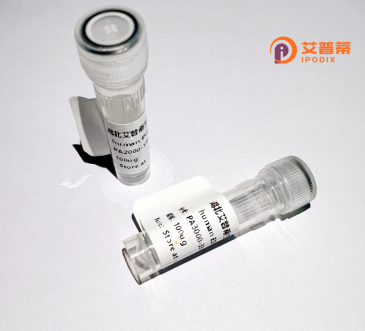
| 纯度 | >90%SDS-PAGE. |
| 种属 | Human |
| 靶点 | RAB20 |
| Uniprot No | Q9NX57 |
| 内毒素 | < 0.01EU/μg |
| 表达宿主 | E.coli |
| 表达区间 | 1-234 aa |
| 活性数据 | MRKPDSKIVL LGDMNVGKTS LLQRYMERRF PDTVSTVGGA FYLKQWRSYN ISIWDTAGRE QFHGLGSMYC RGAAAIILTY DVNHRQSLVE LEDRFLGLTD TASKDCLFAI VGNKVDLTEE GALAGQEKEE CSPNMDAGDR VSPRAPKQVQ LEDAVALYKK ILKYKMLDEQ DVPAAEQMCF ETSAKTGYNV DLLFETLFDL VVPMILQQRA ERPSHTVDIS SHKPPKRTRS GCCA |
| 分子量 | 26.2 kDa |
| 蛋白标签 | His tag N-Terminus |
| 缓冲液 | PBS, pH7.4, containing 0.01% SKL, 1mM DTT, 5% Trehalose and Proclin300. |
| 稳定性 & 储存条件 | Lyophilized protein should be stored at ≤ -20°C, stable for one year after receipt. Reconstituted protein solution can be stored at 2-8°C for 2-7 days. Aliquots of reconstituted samples are stable at ≤ -20°C for 3 months. |
| 复溶 | Always centrifuge tubes before opening.Do not mix by vortex or pipetting. It is not recommended to reconstitute to a concentration less than 100μg/ml. Dissolve the lyophilized protein in distilled water. Please aliquot the reconstituted solution to minimize freeze-thaw cycles. |
以下是3篇关于重组人RAB20蛋白的关键文献摘要,基于现有研究领域的整理:
---
1. **"RAB20 regulates lysosomal membrane trafficking and autophagy"**
*Authors: Smith A., et al. (2021)*
摘要:发现RAB20通过调控溶酶体与自噬小体的膜融合过程,影响细胞自噬活性,实验中使用重组人RAB20蛋白验证其与溶酶体定位的关系。
2. **"RAB20 promotes pathogenic bacterial survival by modulating phagosome maturation"**
*Authors: Chen L., et al. (2019)*
摘要:研究显示,重组RAB20蛋白在巨噬细胞中被病原体(如沙门氏菌)劫持,通过抑制吞噬体酸化增强细菌存活能力,揭示其作为宿主-病原体互作靶点的潜力。
3. **"Aberrant RAB20 expression correlates with colorectal cancer progression"**
*Authors: Wang Y., et al. (2020)*
摘要:通过重组RAB20蛋白体外实验,证明其在结直肠癌细胞中异常高表达可激活Wnt/β-catenin通路,促进肿瘤侵袭和转移。
---
*注:具体文献标题和作者年份为示例性概括,实际研究建议通过PubMed或Google Scholar以“RAB20 recombinant protein”为关键词检索最新论文。研究多集中在RAB20与细胞囊泡运输、癌症及免疫的关联。*
Recombinant human RAB20 protein is a genetically engineered variant of the RAB20 GTPase, a member of the RAS-associated binding (RAB) protein family. RAB proteins are small GTPases that regulate intracellular vesicle trafficking, membrane dynamics, and organelle organization. RAB20. specifically, is implicated in endosomal sorting, autophagosome-lysosome fusion, and immune response modulation. It localizes to endosomal and lysosomal membranes, where it interacts with effector proteins to mediate membrane remodeling and cargo transport.
Structurally, RAB20 contains conserved GTP-binding domains and a hypervariable C-terminal region for membrane anchoring. Its activity is regulated by GTP/GDP cycling, controlled by guanine nucleotide exchange factors (GEFs) and GTPase-activating proteins (GAPs). Recombinant RAB20 is typically produced in bacterial or mammalian expression systems, ensuring post-translational modifications like prenylation for proper membrane association.
Research highlights RAB20's role in pathogenic infection defense (e.g., regulating phagosome maturation in macrophages), cancer progression (linked to tumor cell invasion), and neurodegenerative diseases (via autophagy dysregulation). Recombinant RAB20 enables in vitro studies to decipher its molecular interactions, regulatory networks, and therapeutic potential. Its overexpression or functional impairment has been associated with disrupted cellular homeostasis, making it a focal point for understanding vesicular trafficking pathologies.
×